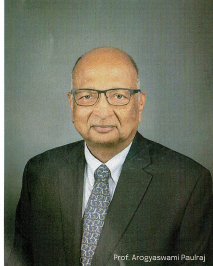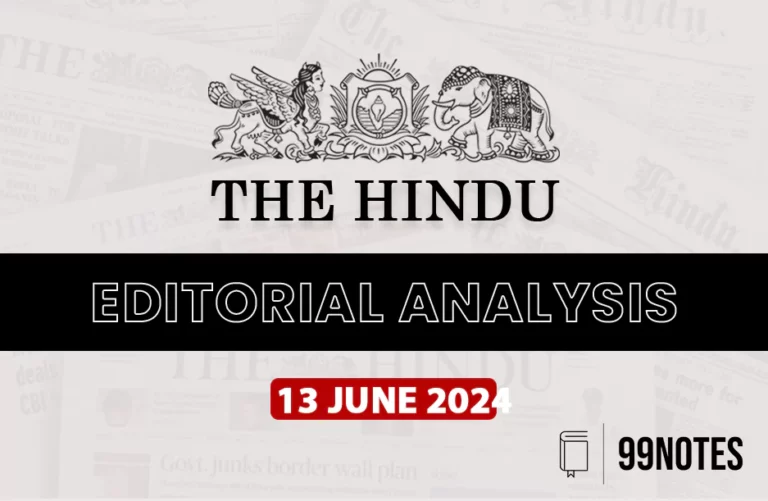20 April 2024 : The Hindu Editorial Notes PDF
The Hindu EDITORIAL
20-April-2024
1. Israel, a two-state solution, some recent perceptions.
|
Topic: GS2 – International Relations. Critical for UPSC due to its implications for international relations, conflict resolution, and understanding regional geopolitics in the Middle East. |
| Context |
| ● The article provides a comprehensive overview of the Israeli-Palestinian conflict, focusing on the challenges and perceptions surrounding the two-state solution. |
Current Status of Israel
- Israel, a Middle Eastern nation, has long been embroiled in conflicts over territory, particularly with the Palestinian population.
- Established in 1948, Israel’s sovereignty is recognized by many nations, but its borders remain a contentious issue, with disputes over territories like the West Bank and Gaza Strip.
Two-State Solution
- The two-state solution proposes the creation of two separate states, Israel and Palestine, living side by side in peace and security.
- This solution aims to address the aspirations of both Israelis and Palestinians for self-determination and sovereignty over their respective territories.
Recent Perceptions on the Two-State Solution
- Recent perceptions on the two-state solution vary widely among different stakeholders, both within Israel and internationally.
- Some view it as the most viable path to achieve lasting peace in the region, while others criticize it as impractical or insufficient to address underlying issues.
Support for the Two-State Solution
- Many international actors, including the United Nations and various countries, have endorsed the two-state solution as the preferred framework for resolving the Israeli-Palestinian conflict.
- They argue that it offers a just and equitable resolution by recognizing the rights and aspirations of both Israelis and Palestinians.
Challenges to the Two-State Solution
- Despite widespread support, the two-state solution faces numerous challenges that hinder its realisation.
- These challenges include territorial disputes, security concerns, the status of Jerusalem, Palestinian refugees’ rights, and the expansion of Israeli settlements in the occupied territories.
Israeli Perspectives
- Within Israel, opinions on the two-state solution vary across the political spectrum.
- Some Israeli leaders and citizens advocate for a negotiated settlement leading to the establishment of a Palestinian state alongside Israel, citing security and demographic concerns.
- However, others, particularly within conservative and nationalist circles, reject the two-state solution, preferring to maintain Israeli control over the entire territory.
Palestinian Perspectives
- Palestinians, too, hold diverse views on the two-state solution.
- While many support the establishment of an independent Palestinian state, they emphasise the need for sovereignty, territorial contiguity, and the right of return for Palestinian refugees.
- Some Palestinian factions, such as Hamas, reject the two-state solution altogether, advocating for the liberation of all Palestinian territories from Israeli occupation.
International Diplomatic Efforts
- Various international diplomatic efforts have been made to advance the two-state solution, including peace negotiations, multilateral initiatives, and diplomatic interventions.
- However, progress has been limited, with peace talks often stalling due to disagreements over key issues such as borders, security, and the status of Jerusalem.
Conclusion
- In conclusion, the two-state solution remains a central and contested issue in the Israeli-Palestinian conflict, with divergent perspectives and significant obstacles to its realisation.
- Achieving a sustainable peace settlement will require concerted efforts from all parties involved, along with international support and diplomacy, to address the complex and longstanding grievances on both sides.
|
PYQ: Q. The term “two-state solution” is sometimes mentioned in the news in the context of the affairs of: (a) China Ans: Option B (UPSC civil services prelims 2018) |
| Practice Question: Discuss the viability of the two-state solution for resolving the Israeli-Palestinian conflict, considering challenges and differing perspectives. (250 Words /15 marks) |
2. Scientists and a wish list for the incoming government
|
Topic: GS2 – Governance – Government policies. Critical for UPSC to understand scientists’ demands, influencing policies on R&D, infrastructure, hiring, grants, and academic freedom. |
| Context |
| ● The article discusses scientists’ expectations from the Indian government, focusing on R&D funding, infrastructure, merit-based hiring, grant management, and academic freedom. |
Overview of Scientists’ Expectations in Elections
- Scientists in India are urging the new government to address critical issues concerning research and development (R&D) funding, infrastructure, merit-based hiring, grant management, and academic freedom.
- These expectations are crucial for advancing scientific research, innovation, and knowledge creation in the country.
Increase Spending on R&D
- Scientists emphasise the need to boost the nation’s R&D expenditure, aiming for a significant increase in both government and private sector contributions.
- They propose a target of at least 4% of GDP allocated to R&D, with private sector involvement through initiatives like the Anusandhan National Research Foundation (ANRF).
Improving Infrastructure
- There is a call for enhancing physical and intellectual infrastructure in public sector institutions, including universities and research centres.
- Upgrading laboratories, modernising facilities, and hiring more qualified teachers and researchers are essential to foster scientific excellence.
Focus on Merit-based Hiring
- Scientists advocate for transparent and merit-based hiring processes in educational and research institutions, free from external influence.
- Establishing global standards for selection criteria and expediting the appointment process within six months are emphasised.
Robust Grant Management System
- A streamlined grant management system with minimal bureaucracy is deemed necessary to facilitate research.
- This includes faster grant disbursal, autonomy for scientists in fund utilisation, and flexibility in purchasing research materials.
Ensuring Academic Freedom
- Scientists stress the importance of academic freedom, allowing researchers to speak and write based on evidence without interference.
- Providing autonomy for scientists to engage in entrepreneurship, hiring, spending, and travel is essential for fostering innovation.
Conclusion: Importance for India’s Growth
- The fulfilment of scientists’ expectations is crucial for India’s economic growth and global competitiveness.
- By addressing these issues, the government can support scientific research, innovation, and entrepreneurship, contributing to India’s development goals.
- Scientists, as a significant electoral block, can influence decision-making for the greater public good, emphasising the importance of their concerns in national policies.
| Scientific Research And Innovation In India: |
|
Significance: ●Economic Growth: Scientific research and innovation are key drivers of economic growth, productivity enhancement, and competitiveness, fostering innovation-led growth and sustainable development. ●Technological Advancement: Research and innovation contribute to technological advancements, breakthroughs, and discoveries in various fields, including healthcare, agriculture, energy, and information technology, propelling India towards global leadership. ●Global Competitiveness: Investing in research and innovation enhances India’s global competitiveness, positioning it as a knowledge economy and a hub for innovation and entrepreneurship. ● Quality of Life: Scientific research leads to the development of new technologies, products, and services that improve quality of life, address societal challenges, and meet the needs of citizens in areas such as healthcare, education, and environmental sustainability. ● Job Creation: Innovation-driven industries and knowledge-based sectors create employment opportunities, foster talent development, and contribute to inclusive growth and poverty reduction. Challenges: ● Infrastructure and Funding: Inadequate research infrastructure, facilities, and funding hinder scientific research and innovation efforts, limiting the capacity for cutting-edge research and development. ● Human Capital: Shortage of skilled researchers, scientists, and engineers, as well as brain drain, talent retention challenges, and limited interdisciplinary collaboration, pose obstacles to scientific advancement. ● Regulatory Environment: Complex regulatory frameworks, bureaucratic hurdles, and lengthy approval processes impede research initiatives, innovation activities, and technology commercialization. ● Industry-Academia Collaboration: Limited collaboration between academia, industry, and government, weak industry-academia linkages, and insufficient technology transfer mechanisms inhibit innovation diffusion and commercialization. ●Intellectual Property Rights: Weak intellectual property rights protection, enforcement mechanisms, and patent laws deter investment in research and development, innovation, and technology transfer. Way Forward: ● Investment and Funding: Increase public and private investment in research and innovation, establish research grants, venture capital funds, and innovation funds to support R&D initiatives. ● Infrastructure Development: Strengthen research infrastructure, laboratories, and technology parks, upgrade scientific facilities, and promote public-private partnerships to enhance research capabilities. ● Human Resource Development: Invest in education, training, and skill development programs to nurture a talented pool of researchers, scientists, and innovators, incentivize STEM (science, technology, engineering, and mathematics) education, and promote interdisciplinary collaboration. ● Policy Reforms: Reform regulatory frameworks, streamline approval processes, and create an enabling policy environment conducive to research, innovation, and technology commercialization. ● Industry-Academia Collaboration: Foster closer collaboration between academia, industry, and government through research partnerships, technology transfer offices, incubators, and innovation clusters to accelerate innovation diffusion and entrepreneurship. ● Intellectual Property Protection: Strengthen intellectual property rights regimes, enhance patent laws, and establish mechanisms for intellectual property protection, enforcement, and technology transfer to incentivize innovation and safeguard investments. |
| PYQ: Scientific research in Indian universities is declining, because a career in science is not as attractive as our business operations, engineering or administration, and the universities are becoming consumer oriented. Critically comment.(200 words/12.5m) (UPSC CSE (M) GS-3 2014) |
| Practice Question: Discuss the key expectations of scientists from the Indian government regarding research and development, infrastructure, hiring, grants, and academic freedom. (150 Words /10 marks) |
For Enquiry

20 April 2024 : The Hindu Editorial Notes PDF

20 April 2024 : Indian Express Editorial Analysis

SCIENCE REPORTER SUMMARY: JANUARY 2024

19 April 2024 : Daily Current Affairs Quiz

19 April 2024 : Daily Answer Writing

19 April 2024 : Daily Current Affairs

19 April 2024 : PIB Summary for UPSC

19 April 2024 : The Hindu Editorial Notes PDF

19 April 2024 : Indian Express Editorial Analysis

18 April 2024 : Daily Current Affairs Quiz
April 2024 The Hindu Editorial 20 April 2024 : The Hindu Editorial Notes PDF The Hindu EDITORIAL
20-April-2024
1. Israel, a two-state solution, some recent perceptions.
Topic:…
April 2024 Indian Express 20 April 2024 : Indian Express Editorial Analysis Indian Express Editorial Analysis
20-April-2024
1. A BITTER SWEET
Topic: GS2 – Social Justice –…
Science Reporter SCIENCE REPORTER SUMMARY: JANUARY 2024 ARTICLE 1: India-born Prof. Arogyaswami Paulraj Receives Faraday Medal for Pioneering MIMO Technology
Awards…
Daily Quiz 19 April 2024 : Daily Current Affairs Quiz 19- April 2024 : Daily Quiz…
mains answer writing 19 April 2024 : Daily Answer Writing Mains Answer Writing
19-April-2024
Q1) Critically evaluate the performance of Goods and Services Tax…
April 2024 Daily Current Affairs 19 April 2024 : Daily Current Affairs Daily Current Affairs
19-April -2024- Top News of the Day
1. Indigenously built cruise missile successfully…
April 2024 PIB 19 April 2024 : PIB Summary for UPSC PIB Summary for UPSC
19-April-2024
1. IREDA’s GIFT City office to boost Green Hydrogen and Renewable…
April 2024 The Hindu Editorial 19 April 2024 : The Hindu Editorial Notes PDF The Hindu EDITORIAL
19-April-2024
1. A world in disarray, a concern about the future
Topic: GS2…
April 2024 Indian Express 19 April 2024 : Indian Express Editorial Analysis Indian Express Editorial Analysis
19-April-2024
1. Clash of aspirations
Topic: GS3 – Indian Economy
This…
Daily Quiz 18 April 2024 : Daily Current Affairs Quiz 18- April 2024 : Daily Quiz…



